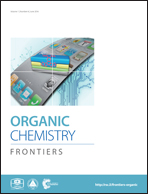Efficient synthesis of a library of heparin tri- and tetrasaccharides relevant to the substrate of heparanase†
Abstract
The glycosylation reaction for construction of the challenging α-GlcN–(1→4)-GlcA/IdoA linkages has been investigated carefully. A standard protocol was thus fixed that employed 2-azido-glucopyranosyl N-phenyl trifluoroacetimidates as donors, TMSOTf as a catalyst, toluene as a solvent, and −30 °C as the working temperature. With this protocol, a variety of mono- and disaccharide donors and acceptors were condensed reliably to provide the corresponding coupled tri- and tetrasaccharides in satisfactory yields and α-selectivity, whereas a remote protecting group or a sugar unit in either the donor or the acceptor did affect considerably the outcome. The resulting tri- and tetrasaccharides bearing orthogonal protecting groups were then converted efficiently into the corresponding heparin tri- and tetrasaccharides via a robust approach involving saponification, O-sulfation, azide reduction, N-sulfation/N-acetylation, and global debenzylation. These heparin tri- and tetrasaccharides are structurally relevant to ΔHexA(2S)–GlcN(NS,6S)–GlcA–GlcN(NS,6S), a reported substrate of heparanase, and therefore could be exploited to examine the substrate specificity of this important enzyme.


 Please wait while we load your content...
Please wait while we load your content...